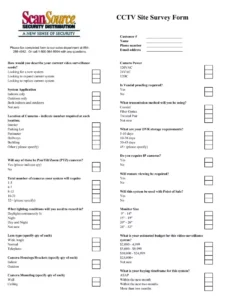Navigating the complex world of government contracts can feel like a labyrinth, especially when you are dealing with critical infrastructure projects like fiber optic deployments. These aren’t just any jobs; they demand precision, meticulous planning, and an unwavering commitment to detail and compliance. Before a single strand of fiber is laid or a connection is made, the foundational step is always a thorough site survey. Without it, you are essentially building blind, risking costly errors, delays, and even non-compliance with strict government regulations.
This is where a robust and well-structured site survey becomes your most valuable asset. For government contractors, simply ‘looking around’ isn’t enough. You need a systematic approach to gather every piece of relevant data, assess every potential challenge, and document every condition that could impact your fiber optic network’s success. A comprehensive template transforms this crucial preliminary phase from an ad-hoc inspection into a standardized, repeatable, and highly efficient process, ensuring nothing is overlooked and your project starts on the strongest possible footing.
The Undeniable Importance of a Detailed Fiber Optic Site Survey
Before any trench is dug or conduit is run, a fiber optic site survey acts as the eyes and ears for your entire project. Imagine starting construction on a multi-million dollar government network without truly understanding the terrain, existing utilities, environmental factors, or even local permitting nuances. It is a recipe for disaster. For government contractors, the stakes are even higher due to the sensitive nature of the work, strict deadlines, and often, critical mission requirements. This initial survey phase is where potential roadblocks are identified, risks are mitigated, and the most efficient and cost-effective deployment strategy begins to take shape.
A truly effective site survey goes far beyond a quick visual inspection. It involves a deep dive into the physical environment, existing infrastructure, and regulatory landscape. You are looking to identify everything from soil conditions that might impact trenching to the availability of power, existing rights-of-way, and potential interference from other communication systems. Each piece of data collected during this phase directly informs the network design, material procurement, and deployment methodology, ultimately impacting the project’s budget and timeline. Missing even one crucial detail can lead to significant rework, unforeseen expenses, and project delays that can jeopardize your contractual obligations.
Moreover, for government contracts, there is an added layer of scrutiny regarding security and compliance. Your site survey must also account for specific agency requirements, potential security vulnerabilities, and adherence to various federal, state, and local codes. This might involve assessing physical security measures, secure access points, and even considerations for electromagnetic interference or other sensitive environmental factors. The data gathered here forms a critical part of your overall project documentation, which is often subject to review and audit by government oversight bodies.
Think of the site survey as your blueprint for success. It is the phase where assumptions are replaced with hard data, and potential problems are transformed into actionable solutions. A well-executed survey ensures that the subsequent design and deployment phases are based on accurate, real-world conditions, minimizing surprises and maximizing efficiency. This diligent approach not only safeguards your project but also builds immense trust with your government client, showcasing your professionalism and foresight.
Key Information to Gather During Your Survey:
- Existing infrastructure and utility locations (underground and aerial)
- Terrain and geographical features (elevation changes, soil type, water bodies)
- Access routes and potential logistical challenges for equipment and personnel
- Environmental considerations (wetlands, protected areas, historical sites)
- Power availability and grounding requirements
- Building entry points and internal routing possibilities
- Local permitting requirements and jurisdictional authorities
- Security considerations and access restrictions for sensitive areas
- Potential electromagnetic interference (EMI) sources
- Right-of-way and easement documentation
Crafting and Utilizing Your Government Contractor Fiber Optic Site Survey Template
Having understood the immense value of a comprehensive site survey, the next logical step is to standardize this process through a robust template. A government contractor fiber optic site survey template is not just a checklist; it is a dynamic tool that ensures consistency, thoroughness, and replicability across all your projects. It acts as a consistent framework, guiding your survey teams through every necessary step, ensuring no critical data point is missed, and that all relevant information is captured in a uniform manner, regardless of who is performing the survey.
Creating an effective template involves structuring it logically to capture all the multifaceted details required for a fiber optic deployment. Think about breaking it down into sections that correspond to different aspects of the survey: administrative details, physical site characteristics, existing infrastructure, technical requirements, safety considerations, and regulatory compliance. Each section should have clear prompts and fields for data entry, including spaces for observations, measurements, photographs, and even simple sketches. This systematic approach ensures that the collected data is not only complete but also easy to interpret and utilize by your design and engineering teams.
Moreover, a standardized template is invaluable for quality control and training. It serves as an excellent training tool for new survey technicians, familiarizing them with the specific requirements and meticulousness demanded by government projects. For project managers, it offers a quick overview of survey progress and identified issues, streamlining decision-making. In the event of an audit or dispute, the template provides a clear, documented record of the site conditions at the time of the survey, adding a layer of accountability and transparency that is highly valued in government contracting.
Remember, a template is a living document. As you complete more government fiber optic projects, you will inevitably encounter unique challenges and learn valuable lessons. Use this experience to refine and improve your government contractor fiber optic site survey template. Add new sections for recurring issues, clarify ambiguous prompts, and incorporate best practices learned in the field. This iterative improvement ensures that your template remains a cutting-edge tool, continually enhancing your ability to deliver successful fiber optic infrastructure for government clients.
Ultimately, mastering the art of the fiber optic site survey, powered by a well-designed template, is a cornerstone of success for any government contractor. It allows you to transform complex preliminary investigations into streamlined, systematic processes, ensuring that every fiber optic deployment is built on a foundation of accurate data and thorough planning. This meticulous approach minimizes risks, optimizes resource allocation, and paves the way for the reliable, high-performance networks that government agencies depend on.



